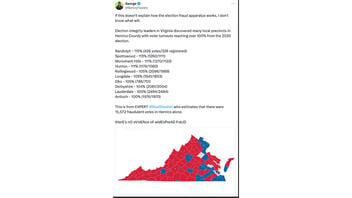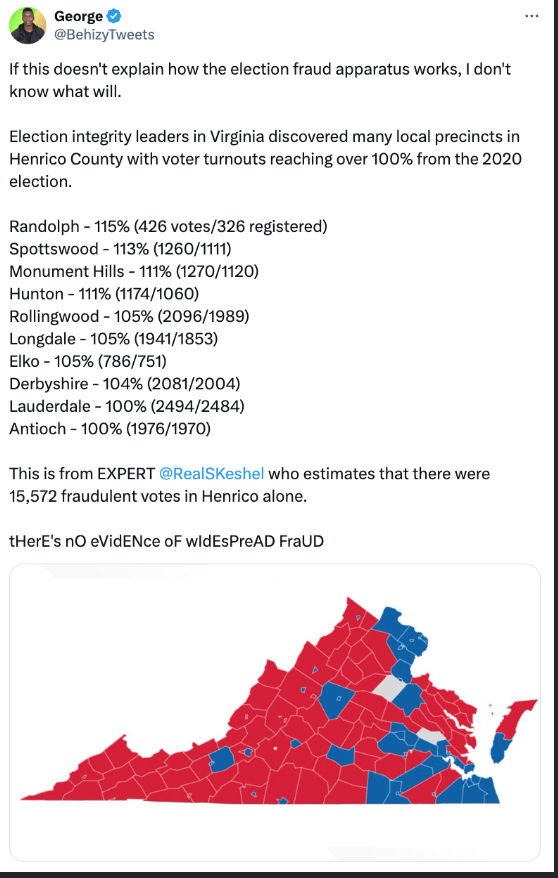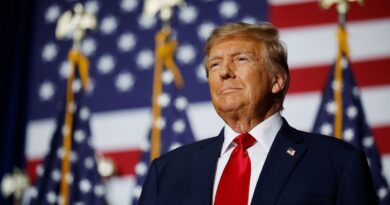Fact Check: Voter Turnout Was NOT Above 100% In 2020 In Some Precincts In Henrico County, VA

Was voter turnout above 100 percent in 2020 in some precincts of Henrico County, Virginia? No, that’s not true: The county director of elections told Lead Stories that assertion is “incorrect.” Counties are not concealing precinct data by “removing the supposed absentee ballots,” he said. Election experts confirmed that the voter data provided by the county was accurate information.
The claim appeared in a post (archived here) on X, formerly known as Twitter, on November 24, 2023. It went viral again in 2024 after Elon Musk retweeted the post (archived here) on October 6, 2024. It began:
If this doesn’t explain how the election fraud apparatus works, I don’t know what will.
Election integrity leaders in Virginia discovered many local precincts in Henrico County with voter turnouts reaching over 100% from the 2020 election.
This is what the post looked like on X at the time of writing:
(Source: X screenshot taken on Tue Oct 08 17:50:21 2024 UTC)
The “expert” linked in the tweet refers to Seth Keshel and his blog post (archived here) titled, “The Hidden Element of Electile Dysfunction: Record Keeping,” that was published on November 25, 2023.
The blog cites the Henrico County statistics for the election and claims there was a “2020 absentee scam” and says they have a “working assumption that they [Henrico County] are concealing absentee votes from precinct counts for a purpose”:
Counties are concealing precinct data by removing the supposed absentee ballots, one of the main methods of defrauding election returns, from the precinct counts.
A chart was included in the blog post showing the breakdown of turnout percent, total registrants, total ballots cast – closing tape and votes by party:
(Source: Substack screenshot taken on Tue Oct 08 23:31:11 2024 UTC)
Mark J. Coakley (archived here), director of elections/registrar for Henrico County, emailed Lead Stories on October 7, 2024, and refuted the claims:
The assertion that some Henrico County precincts experienced 100% or greater turnout in the 2020 general election is incorrect.
Coakley said the reason for the drastic increase in absentee voting in 2020, amid the COVID-19 pandemic, was due to new voting allowances:
The 2020 general election was the first in Virginia that allowed no-excuse, in-person absentee voting (early voting). Statewide, these early voters completed a generic absentee ballot. These ballots did not include the voters’ precinct information. After the 2020 general election, legislation was passed in Virginia requiring the inclusion of precinct information on absentee ballots.
He explained that the methodology was new and therefore not precinct-specific:
For the 2020 general election, Henrico County’s absentee ballots were counted as a lump sum, and not by precinct, since it was not possible to identify the precincts on the absentee ballots. The same was true for all jurisdictions in Virginia.
So, total voter turnout at the precinct level — those who voted in person at their precinct on Election Day combined with early voters — cannot be determined for the 2020 general election. Only the number of in-person voters on Election Day, Nov. 3, 2020, could be counted at the precinct level.
The chart used in the Keshel blog (above in this fact check) is from the Henrico County General Election spreadsheet with county voter data (archived here).
Coakley explained the final tally from the “November totals by precinct” spreadsheet (archived here) that showed how many people voted absentee, in person and with provisional ballots:
In the 2020 general election, Henrico County experienced a total voter turnout of 77.5% — out of 236,922 registered county voters,183,670 cast ballots. As shown in the chart, 72,116 of these voters cast their ballots in person at their precinct on Election Day, Nov. 3, 2020. Another 110,479 voted absentee (and 1,075 voters cast provisional ballots).
The Keshel blog asserts that “Someone has the data of where those ballots came from, and to which voter they belong,” a claim that Coakley denies:
No database existed in 2020. It does now for all Virginia locations.
The tweet making the claim we are focused on cites 10 precincts in Henrico County and says they show votes versus registered voters was over 100 percent:
Randolph – 115% (426 votes/326 registered)
Spottswood – 113% (1260/1111)
Monument Hills – 111% (1270/1120)
Hunton – 111% (1174/1060)
Rollingwood – 105% (2096/1989)
Longdale – 105% (1941/1853)
Elko – 105% (786/751)
Derbyshire – 104% (2081/2004)
Lauderdale – 100% (2494/2484)
Antioch – 100% (1976/1970)
The tweet’s claims don’t match county precinct data (archived here). These are the numbers in the county spreadsheet:
Randolph – 38.21% (141 votes/369 registered)
Spottswood – 45.54% (506 votes/1,111 registered)
Monument Hills – 44.64% (500 votes/1,120 registered)
Hunton – 48.87% (518 votes/ 1,060 registered)
Rollingwood – 42.33% (842 votes/1,989 registered)
Longdale – 38.86% (720 votes/ 1,853 registered)
Elko – 55.93% (420 votes/ 751 registered)
Derbyshire – 44.11% (884 votes/2,004 registered)
Lauderdale – 34.40% (988 votes/2,872 registered)
Antioch – 52.59% (1,036 votes/1,970 registered)
The X account claimed in a subsequent tweet (archived here) on November 24, 2023, that the numbers from the independent resources Redistricter (archived here) and Dave’s Redistricting Atlas (archived here) are the true numbers because they include the mail-in votes and early votes (absentee votes):
Many election fraud deniers are here attempting to debunk this data by quoting the County’s official precinct reporting data. But as expected, they’re clueless about elections. Henrico County and many others in Virginia do NOT include mail in votes & early votes in their individual precinct results reporting, in fact, they deliberately do it to hide the obvious manipulation of mail in ballots
When using independent resources like Redistrictor to analyze the results based on election records that include total number of registered voters and the total number of votes from the precinct (mail in & all other early votes included)
You start to see these obvious discrepancies
John Sebes, chief technology officer (archived here) at OSET Institute (archived here), a nonprofit organization focused on increasing confidence in elections and their outcomes, told Lead Stories via email on October 8, 2024, that this was a “denier conspiracy story.” He explained:
A cursory review of the certification process would show how a situation like what is claimed — a county has more ballots cast than registered voters — would get flagged. If anyone is concerned about dishonest election officials making bogus vote totals, there are other ways to do it that are much less likely to get a Local Election Official (LEO) thrown in jail.
“The lack of logic is pretty clear to me,” Sebes wrote:
- County’s precinct turnout reporting has unremarkable numbers, nowhere near 100% turnout.
- County’s precinct turnout reporting does not include absentee ballots (ABs).
- Claim is that when you add Absentee’s back in, some precincts have > 100% turnout.
- However, county LEOs did not break down ABs by precinct, so ‘adding back’ ABs can’t be done based on LEO’s reporting.
Sebes continued, “So on the face of it, this claim is based on some creative arithmetic and/or misunderstandings. Redistricter is reputable, but it doesn’t help establish credibility of this claim; the site/tool can’t help claimants accurately re-apportion ABs precinct, it is not the purpose of the tool.”
J. Miles Coleman, associate editor of Sabato’s Crystal Ball at the University of Virginia Center for Politics (archived here), spoke with Lead Stories via phone on October 8, 2024. He explained that Redistricter and Dave’s Redistricting Atlas arrived at their numbers using an industry standard formula, which the University of Virginia also uses. He noted that those numbers were an approximation and not a perfect allocation of votes:
Even if they don’t have the absentee vote by precinct, the official state sources still supply the total number of countywide absentee votes. Groups like Redistricter then use a formula to estimate each precinct’s share of that countywide absentee group.
Coleman explained how the two database organization arrive at their specific numbers when the specific information is not available:
The data that the county registers are providing, that is accurate. That is, they are giving you the election day vote by precinct and they’re giving you the whole pot of early absentee vote county wide. What Dave’s Redistricting and Redistricter are doing is they’re running some formula on that pot of county wide early votes to come up with a visual representation that is more accurate than just showing the red election day vote for every precinct.
Genya Coulter, senior elections systems analyst with OSET Institute and former Polk County, Florida, election official, responded to Lead Stories via email on October 8, 2024. Coulter spoke with Redistricter for a clarification of their method of obtaining the results that were published in the blog, which did not match the official county numbers as shown above:
- It was a data conversion issue. The official results were not used to make the dataset.
- The data Seth Keshel uses as ‘evidence’ is election data that has been disaggregated from one geographical category to another (precincts to census block groups) for data visualization purposes.
- But disaggregated data is just an estimate and isn’t as accurate as official results.
- They used VAP (voting age population) data, not confirmed QVF (qualified voter file) data and they also did not include early voting and provisional data.
Other Lead Stories fact checks on claims related to the 2024 election are here.




